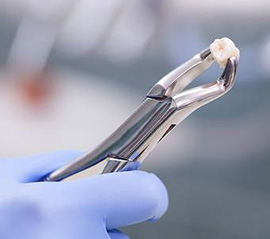


Thanks to our team’s experience and use of technology, we’re often able to save even the most decayed or broken teeth. That said, there are some situations in which a tooth can be so damaged that repairing it is simply impossible. In that case, we will recommend a tooth extraction. Should you or your child ever need a tooth removed, our Fargo emergency dentist will do everything they can to make the entire process stress-free from beginning to end.

As we mentioned above, we only recommend tooth extractions when absolutely necessary. Here are a few examples:
As always, your Fargo dentist will discuss all of your treatment options with you as well as why they think a tooth extraction is best. That way, all of your questions are answered, and you feel confident moving forward with your treatment plan.

The very first step is using a local anesthetic to numb your mouth. Once that has completely set in and you can’t feel anything, we will begin the tooth extraction process. This involves gently gripping the tooth and rocking it loose until it’s ready to be removed. Then, we will tend to the extraction site. Thanks to our gentle touch and a local anesthetic, most patients usually report that they didn’t feel a thing when their tooth came out!

We often remove a tooth with the intention of quickly replacing it with a dental implant. While performing the extraction, we do everything we can to preserve the integrity of the surrounding jawbone, which will make implant placement much easier in the future. By doing this, we can drastically cut down on the time a patient spends with a space in their smile, and we may even save them from having to get a bone grafting procedure.

We will suggest that a patient take the rest of the day to relax after having a tooth removed. This is to ensure that the treatment area is able to fully clot, which is essential to proper healing. The patient will also be given aftercare instructions, including a list of foods that are safe to eat, oral hygiene tips, and indicators that they should call our office. On average, a patient’s mouth should feel relatively normal after about three days. Patients with physically demanding jobs may be asked to take a few days off because too much activity can interfere with the clotting process.

If you need a tooth extracted due to damage, decay, wear, or impaction, you may be wondering what factors may affect the procedure’s cost. The truth is, many things can influence the price, including the location of the tooth and the type of extraction needed.
Thankfully, your dental insurance may provide some coverage for this procedure, and additional financing may be available for qualified patients. Keep reading to better understand the cost of your tooth extraction procedure.

It is difficult to estimate the exact cost of your tooth extraction until Dr. Majidian can examine the tooth or teeth and determine the scope of the procedure. Many factors can influence the cost of your extraction, including:
Your dental team will provide you with an estimated total cost for your treatment at the time of your consultation and can explain in greater detail what factors are used to determine this amount.

Typically, dental insurance will cover at least some portion of the cost of tooth extractions, usually at around 50 percent of cost after your deductible has been met. This includes wisdom teeth.
However, please be aware that there may be limits in place that will only cover a certain number of teeth. You may also have a waiting period before your coverage takes effect, but this will depend on your individual plan. Each plan is different, which is why it is important that you speak to your insurance company first. The team at Cornerstone Dental will be happy to assist you with confirming coverage prior to your extraction.

For patients who either do not have dental insurance or need assistance covering the balance of what their insurance will not cover, Cornerstone Dental offers financing options through CareCredit and Lending Club. You can easily locate applications for these financiers right on our website.
At Cornerstone Dental, we’re ready to help you with all aspects of your tooth extraction, including understanding the cost of your treatment. If you have any questions or concerns about the procedure, payment, or aftercare, please don’t hesitate to contact us at your earliest convenience.
The mouth is always thoroughly numbed before any extraction, so while a patient may feel a little pressure during the procedure, it won’t resemble pain in the slightest. Typically, discomfort only develops afterward in the form of minor soreness and swelling. This can usually be easily managed with OTC pain medication and a cold compress. By following a dentist’s aftercare instructions, the pain will quickly reside.
While there are several treatments available that can be used to save damaged or decayed teeth (like fillings, crowns, gum disease therapy, root canals, etc.), by the time a dentist recommends a tooth extraction, this usually means that it is the only option. The tooth is likely beyond repair, and leaving it in place may allow a localized problem to spread throughout the mouth. The best way to avoid a tooth extraction is to prevent it from being needed in the first place, which can be done by brushing and flossing consistently as well as attending regular dental checkups.
Our practice does not offer general anesthesia, and in most cases, it is not necessary for a tooth extraction. Putting a patient to sleep introduces several complications into the procedure, in addition to extra expense, and local anesthetic is more than enough to keep someone comfortable. We would only recommend general anesthesia in very specific situations, such as if the extraction is very complicated or the patient has issues sitting still.
Most dental insurance plans classify tooth extractions as advanced restorative care, meaning they may cover up to 50% of the cost of the procedure. Benefits can vary quite a bit from plan to plan, however, so we recommend going over your policy with your provider and/or our team first so you can have a much more concrete idea of what you’ll be expected to pay out of pocket.